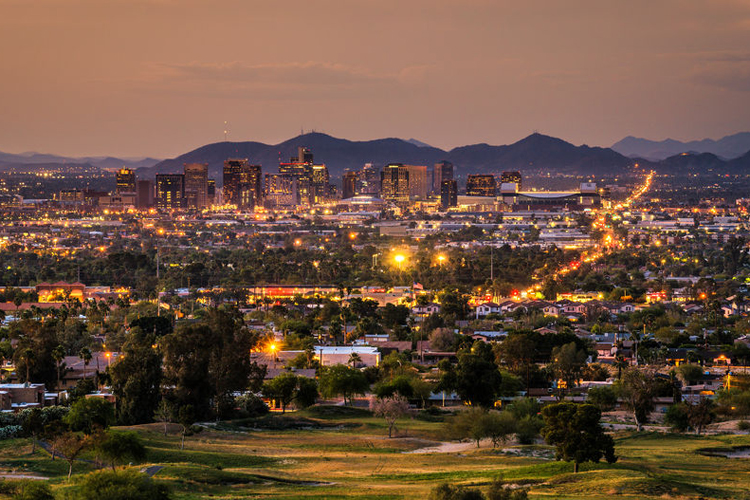It worked.
It may be hard to convince anyone among the more than 222,500 metropolitan area workers losing jobs in April that there is any good news on the job front.
A post-Great Recession economic development policy change by Arizona, Phoenix, and Valley cities about recruiting jobs succeeded. The April employment report has some bright spots in the dark clouds.
An entire year of Valley job gains was wiped out in 30 days with the metropolitan area unemployment rate climbing from a record low 3.7 percent unemployment rate in December 2019 to a never-seen-before-rise to a seasonally adjusted 12.6 percent in April 2020, according to the Arizona Office of Economic Opportunity.
Compared to the rest of the nation, Phoenix fared much better. Nationally, the unemployment rate hit 14.7 percent. In California, and some metro areas in the rust belt hit around 20 percent and more.
Here’s what worked
“This shows that government can influence the economy in positive ways,” said Jim Rounds, private sector strategic economist and president of Rounds Consulting Group. “During the Great Recession, Arizona and cities finally put together a cohesive economic policy to go after high-value jobs.”
In nearly every national recession since the 1960s and until 2008, the Valley showed an economic growth chart that looks like a Six Flags roller coaster ride. As the Phoenix metro started climbing ahead of the economy, the population surged into the Valley when workers and retirees in other areas sold their homes, packed up their equity and settled into a new Phoenix area house. Retail followed rooftops, and the economy was humming along, waiting for the next plunge.
“I think we see that despite the unprecedented job losses, changes in the composition of the workforce kept Arizona’s numbers better than the rest of the U.S.,” said Doug Walls, labor market information director at the Arizona Economic Opportunity Office and lead of the state’s research team for workforce and employment information. “You look at some of the sectors, and our job losses were significantly less than the rest of the nation.”
Many advanced industries added jobs in April
The losses in the metropolitan area service industries were overwhelming in April 2020 compared to April 2019. Hospitality—lodging and restaurants—shed 92,200 jobs in April, retail lost 36,400—6,900 more jobs than the bottom of the Great Recession. Even during the economic boom in 2019, retail never regained all of the jobs lost between 2007 and 2010. Half the jobs lost in April, 128,600 were in those two sectors. The bright spots, groceries and building supplies added 3,000 jobs between the two subsectors.

According to April’s data, some employment trends are changing direction. With the economy plummeting, Phoenix still showed strong job gains in the advanced industry sectors. It’s in those sectors that Phoenix and other metropolitan area cities, and the state focused on new company recruiting efforts over the 10 years since 2010.
As a sector, manufacturing was flat, no jobs lost in year-over-year comparisons, but the aerospace, computer and electronic device production subsectors added 1,000 jobs. Wholesale trade added 1,200. Financial activities added 9,500 jobs, and the bioscience healthcare sector added 10,100 new jobs. Other specialty subsectors added jobs as well.
Between the advanced industries, the Phoenix metro added 22,100 jobs. During 2019, the average month gained over 30,000 jobs in year-over-year comparisons with 2018. In April 2020, advanced industry job gains were close to two-thirds of 2019 average monthly job gains in year-over-year data. Technology jobs are spread across all industry sectors, so the gains reported don’t show as an individual industry in the monthly reports.
Planning for the next recession during the Great Recession
Back in 2009 and 2010, during the Great Recession, Valley mayors came to an understanding that instead of fighting each other for the next power center or auto mall, the economic development emphasis should be to attract a category of jobs called “advanced industries.” With the state on board, Phoenix’s quest for quality jobs was one step leading to the creation of the Arizona Commerce Authority and serious changes in local economic development policies.
Today more than 60 percent of the private sector works in the advanced industry sectors: business and financial services, bioscience and healthcare, manufacturing or technology. It wasn’t that way in 2008 when the economy crashed.
“Economic development was a different world before the Great Recession,” said Christine Mackay, director, Phoenix Community and Economic Development. “Because cities survive on sales tax, there were constant fights for big sales-tax generators—power centers, auto malls, regional shopping centers. The jobs they brought, while important, didn’t bring the value we needed to see this economy grow properly.”
The great lesson of the Great Recession
On the eve of the Great Recession in October 2007, a record-setting employment month in the metro area, more than half the Valley’s private sector workforce was in consumption jobs: construction, retail, real estate. The consumption industries essentially circulate the same money inside the market. Economists say that if there’s a lack of new money coming into the market, it’s hard to grow the economy.
“We talked with mayors about the core values of economic development,” said Chris Camacho, president and CEO of the Greater Phoenix Economic Council. Camacho was a senior executive with GPEC when the conversations took place in 2010 and 2011. “We showed how the region needed balance and diversification when it came to jobs.”
The mayors agreed to new policies. They realized that an economic growth policy of trying to outbid each other for the next sales-tax generator was not the way to stabilize the economy.
“Phoenix has always performed better than the state, economically, and Arizona would outperform the nation during recessions. The Great Recession changed all that,” said Rounds,. “The (economy in the) rest of the nation would drop more than us, and in Phoenix, construction would start building us out of the recession before the rest of the country.”
Some economic observers believed, according to Rounds, that it was a good thing the metropolitan area was dependent on “building itself out of a recession.” In those days, as a recovery moved across the country, it was common for workers to cash in equity and move to Arizona. The fast recovery in Phoenix was an appealing new destination.
“We had this retail and rooftop economy,” said Mackay. “For years, it worked to get the Valley out of a recession. Build homes, retail would follow, families flowed in.”
In 2010, as the recession was “declared over” in the rest of the U.S., people were not moving west. Across the U.S., many who would normally sell a home and move to Phoenix, lost both their jobs and their home equity. Retirement accounts drained. Savings disappeared. This time, the state was not going to build itself out of the recession. When the rest of the nation was rocketing to recovery in 2011, Arizona languished.
“Customer service, retail, construction and hospitality industries gain employment quickly after a recession,” Camacho said. “Based on consumer spending, they are the first industries to shed jobs dramatically. Our base industries were shredded. The service sector just stopped. The demand for services was flat.”
The Great Recession was devastating to the market and shattered all precedents. The metro area jobs lost in 2008 were not recovered until 2014, dragging the impact for six years, more than three years beyond recovery for the rest of the country.
Some industry sectors have yet to recover. Construction and retail jobs were lower in December 2019, Phoenix’s highest month of job numbers since the pre-recession peak, than they were in October 2007, the peak employment month before the Great Recession.
The COVID-19 recession is hitting a different Phoenix
“Phoenix is faring a lot better than the rest of the U.S. economy,” said Walls. “It’s not just from one set of data. We looked at multiple data sets, and Arizona dropped less than most states.”
Walls and W.P. Carey School of Business economists Dennis Hoffman and Lee McPheters at Arizona State University follow job numbers closely. Of all U.S. metros over one million population, Phoenix and Dallas had the lowest year-over-year April job loss, 7.6 percent, according to U.S. Bureau of Labor Statistics data on the ASU Job Growth USA website.
“As a whole, we did a lot better than the rest of the country because we allowed manufacturing and other key revenue-generators to stay open,” said Dennis Hoffman, professor of economics and director of the Seidman Research Institute in the W.P. Carey School of Business at Arizona State University. “Other states had more narrow definitions of essential businesses than Arizona, and those states were hit much harder.”
With the April job losses, the workforce in April 2020 is still larger than the pre-Great Recession peak month of October 2007. The April percent of the employed population, 40.5 percent, is almost identical to the Great Recession trough line at 40.0 percent.
“I think people should expect continued job losses in May,” said Walls. “But not at the level we saw in April.”
Jim Rounds agrees we’re not yet at the bottom.
“The lower-wage jobs in retail and hospitality disappear first,” he said. “Companies have too much invested in skilled workforces and will try to hang on to the high wage employees longer. There’s too much cost in retraining if furloughed employees take other jobs.”
Federal policy is slow to work
It took eight years for the metropolitan area to recover from the Great Recession. Lee McPheters, research professor and director of the J.P. Morgan Chase Economic Outlook Center, sees the economy starting to turn by the third and fourth quarters this year.
“You have to look at the scale of the economic impact,” he said. “The federal response to the (Covid Recession) is four to five times the size of anything that was done in 2008 to 2009.”
McPheters cautions that federal monetary policy is slow to work.
His colleague, Dennis Hoffman, , says that Phoenix prepared for its next recession while the Great Recession was still underway. A macroeconomist, Hoffman explained that Phoenix’s shift to an export economy helped bring more dollars into the Valley after the Great Recession than were seen in 2007.
“We saw a real shift in policy,” said Mackay, who was economic development director in Chandler at the time. “Economic developers started pitching companies to bring in or grow high-value jobs. We looked at jobs that had large indirect benefits.”
Camacho echoes Mackay’s thoughts while recalling the conversations with the mayors nearly a decade ago.
“We doubled down on advanced industries,” he said. “Sure, engineering jobs are good, but one engineering job indirectly creates five other jobs in the economy.”
Camacho said that the Valley mayors understood that the economy needed change to grow, launching several new initiatives. Local governments started making policy changes and pushing to recruit high-wage jobs.
“As economic developers, we were able to show how one new job creates other jobs,” said Mackay. “A company hires an engineer, and they need supplies. The supplier hires another person to be able to grow and serve the company. The property manager needs more people for building maintenance and upkeep, creating another job. The new job creation continuously ripples through the entire Valley economy.”
New initiatives put to work
From these efforts at GPEC, the regional initiatives found traction. Under then Gov. Jan Brewer, the state created the Arizona Commerce Authority in 2011, a quasi-public agency replacing the former Arizona Department of Commerce. New incentive programs at the state level tied a measurable return-on-investment to the value of the tax credits and corporate recruitment packages. The role of ACA grew under the direction of now Gov. Doug Ducey.
The city of Phoenix put a major emphasis on creating an export economy and led the state to three consecutive record years of export growth. Arizona and the Phoenix metro rose to the top of national and regional economic growth by 2013. Job recovery lagged 2007 numbers but started to accelerate. Partner organizations, like the Greater Phoenix Chamber of Commerce and the Arizona Chamber of Commerce and Industry, joined the movement to attract advanced industries. Phoenix created the Metropolitan Phoenix Export Alliance, now run by the Phoenix Chamber. With them, the Global Chamber found traction in the Phoenix exporting industry ecosystem making another network available to businesses wanting to expand into international markets.
The ACA, GPEC, Phoenix and other Valley cities focused on bringing in high-value jobs in the advanced industry sectors.
When the state and Phoenix metro finally broke through the 2007 pre-Great Recession job numbers in 2014, employment diversification was the regional foundation setting the stage to help weather the Covid Recession.
“There is no question that the jobs in Phoenix today are different than they were before the Great Recession,” said Hoffman. “Clearly, the sectors are more diversified now than they were then.”
In 2020, Phoenix is resilient
Not shutting off manufacturing, such as was done in Ohio, and allowing car dealers to remain open, are examples of one difference for Arizona in the Covid Recession, according to Hoffman. The diversity of the workforce is something that McPheters believes will help Phoenix recover more quickly in the current recession.
“The diversity of jobs across sectors in 2020 is what is holding up the economy,” said Hoffman. “The closures hit jobs in the retail and service sectors the most, and those are groups that also recover quickly.”
Rounds reflects the same belief.
“There is no doubt this recession has really hurt those who can least afford it,” he said. “However, the strength in the core industries will start the economy humming again faster than previous recessions.”
McPheters is not worried about Phoenix taking too long to rise again, and he sees the city’s growth as a magnet that will grow the economy.
“We have a better diversity of jobs in Phoenix today,” he said. “This is going to continue to attract the workforce to relocate into the Valley. With the economy reopening, things could be very different in two or three months.”
They could go either way, he cautions, because of unforeseen events, as the pandemic did in March and April.
A different ‘new normal’
“The ‘new normal’ could be different,” Hoffman said. “Companies have always been hesitant about teleworking, but over the last few months, they have learned how to manage teleworkers. The Covid Pandemic could change how and where people work.”
Industrial maker spaces are still enjoying brisk leasing activity, according to numbers from commercial real estate brokerages reported in Phoenix media. The big question that real estate publications like Globe St. and BisNow are asking is what will become of the large open office and how with that effect workforce deployment?
“Teleworking may change the way companies lease space,” said Mackay. “What we also see is that workers in other markets where housing affordability is already a serious problem may decide to telework from places with a better quality of life and more affordable housing options. Phoenix offers that environment.”
Hoffman backs up Mackay’s contention.
“Already, Silicon Valley companies are talking about workforce locating outside of the Bay Area,” Hoffman said. “Phoenix has a lifestyle well-positioned to be compatible with that of Californians and other urban dwellers.”
The numbers back the thought. In 2018, the last year for which Census Bureau data are available, the population of a mid-sized city, over 65,000 Californians, migrated to Phoenix and Arizona. Texas and Illinois were next on the list in the U.S., but after California, the next largest source of the new inbound population to Arizona was from Asia, increasing the workforce quality, according to the Census Bureau.
Data show that new migrants to Arizona come with more college degrees and high levels of professional skills, a combination that bolsters the attractiveness of the Phoenix workforce.
“We’ll get through this downturn,” said Mackay. “This is Phoenix, named after the bird rising from the ashes. No other city has that in its DNA.”
This story was written by Eric Jay Toll for PHXNewsroom.




